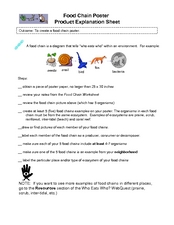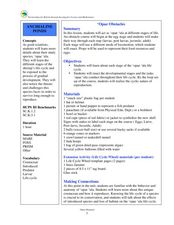Curated OER
Welina's World
Students living in Hawaii draw a picture of themselves in their neighborhood. They draw their neighborhood in relation to their district and then in relation to the island they are from. They compare their pictures to their classmates'...
Curated OER
Food Chain Poster Instructions
In this food chain worksheet, students follow a set of 9 steps to create a food chain poster. Page has no additional activities.
Curated OER
Social Studies:
Students identify various types of breads fromother countries and locate them on maps. In small groups, they make story maps of books that mention bread and make books resembling sandwiches. Students have a bread tasting party and...
Curated OER
Malia
Fourth graders begin their examination of the Hawaiian Islands. Using their island bookmarks from a previous lesson, they work together to put the information into a book. They identify the physical and human characteristics of the...
Curated OER
Build a Polyp
Young scholars research coral polyps. In this coral polyps lesson, students discover the anatomy of a coral polyp and how they feed. Young scholars create an edible coral polyp model.
Curated OER
'O'opu Life Cycle
Students investigate the life cycle of the 'o'opu also known as Hawaiian gobies. In this amphidromous living lesson, students discuss the reproductive cycle, create props and an obstacle course to demonstrate the importance of the...
Curated OER
Lesson 3: Life Cycle of Brassica Plants
Students investigate the life cycle of brassica plants. In this science lesson, students observe each stage in the life cycle of their plant. Students record their observations and graph the data. Students
Curated OER
Opae Obstacles
Students explore the life cycle of shrimp. In this life cycle lesson, students research the different stages of a shrimp's life cycle. Students examine threats to the species in each stage of life.
Curated OER
Exploring Limu Diversity
Young scholars explore limu diversity. In this ocean ecosystem lesson, students classify limu according to its physical properties. Young scholars work in small groups to generate scientific observations and sort limu by characteristics.










